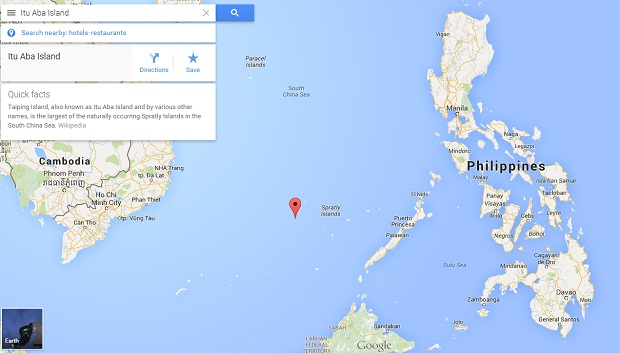Taiwan promotes its island claim in West Philippine Sea

The red marker shows the location of Taiping Island (Itu Aba Island), which is being claimed and occupied by Taiwan. GOOGLEMAPS SCREENGRAB
TAIPEI, Taiwan — As China builds artificial islands in a vast resource-rich South China Sea and neighbors in Southeast Asia brace for possible conflict, Taiwan is cutting carbon emissions and offering a hospital for humanitarian aid on the sea’s largest natural islet to seek international approval for easing tension.
Taiwan’s unusual use of Taiping Island in the heavily contested Spratly archipelago may appeal particularly to the United States, a staunch, long-time informal ally that has at least scrutinized the legal basis for Taiwan’s maritime claims. Washington, seeking stable relations with China as well, has also urged the six claimants to cooperate rather than fight.
Taiping, also called Itu Aba, and the Spratlys, which Manila calls the Kalayaan Group of Islands, are within the portion of the South China Sea which the Philippines refer to as West Philippine Sea. According to the Philippines Department of Foreign Affairs, the West Philippine Sea also includes the Luzon Sea and the sea around Scarborough Shoal, which Filipinos also refer to as Bajo de Masinloc or Panatag Shoal.
Taiwan, which lacks the diplomatic ties to negotiate with the other five governments with claims in the South China Sea, has installed $1.29 million worth of solar panels on Taiping Island since 2011 to light a cluster of buildings and provide power for construction of a 200-meter (yard) pier due for completion by year’s end, the head of the island’s coast guard said Friday.
Panels covering 1,570 square meters (16,890 square feet), enough to save about 32,000 liters (8,450 gallons) of diesel fuel last year, also will supply electricity to a five-bed hospital and living quarters that accept seafarers of any nationality, Coast Guard Administration Minister Wang Chung-yi said.
Taiping receives about 10 foreign boats a year from China or Vietnam, usually during storms. The pier will make it easier for coast guard vessels or – if needed someday — naval ships to dock, allowing more medical supplies to reach the five-bed hospital with a rotating staff as well as a surgery ward. Taiwan also has built a military airstrip on the coast guard-controlled Island.
“No one is in opposition. The United States approves,” Wang said. “When the situation gets tense, our country’s stance is to take a novel approach. Can’t we put aside the dispute? Taiping Island has solar power and green energy that are telling the world we have a different perspective on operating it.”
Taiwan’s design for its 1,400-meter (4,590-foot) -long, 400-meter (1,312-foot) -wide islet contrasts to the campaigns by China and Vietnam to landfill multiple islets, build military bases and drive oil rigs into the ocean floor near the Spratly and Paracel archipelagos. China had added some 2,000 acres (809 hectares) of land in the Spratly chain since last year, U.S. officials said.
Taiwan expects other countries, especially the United States, to respect its efforts, which follow the May 26 announcement of a South China Sea peace and resource-sharing initiative by President Ma Ying-jeou.
The 3.5 million-square-kilometer (1.4 million-square-mile) sea is rich in fisheries, supports about half the world’s commercial shipping and holds an estimated 7 billion barrels of oil reserves. Brunei and Malaysia claim parts of the same ocean.
In signs of growing tension, the Philippines reopened Subic Bay naval base this year and held military exercises with the United States and Japan to help counter any threats from China. Manila has also filed for arbitration in a United Nations court. Last year, Vietnam and China clashed over China’s placement of an oil rig in waters that both sides claim, touching off deadly anti-Chinese riots in Vietnam.
Because China claims sovereignty of Taiwan itself, using economic clout to bar countries throughout the world from establishing diplomatic relations with Taipei, the government relies on soft power to gain recognition.
The U.S. government says China has been unclear about the legal basis for its claim that encompasses most of the sea. Taiwan’s government, the Republic of China, first adopted that basis before 1949 when it ruled all of China. It sticks to that claim today.
“Considering that the … maps predate the People’s Republic of China, the views of Taiwan are also of interest,” the State Department said in a study released last year.
The de-facto U.S. embassy in Taipei said Friday that Washington “appreciates Taiwan’s call on all claimants to exercise restraint, refrain from taking any unilateral action that might escalate tensions,” a reference to the peace initiative. It did not comment on the solar energy program.
Taiwan also may hope to remind Europe, where environmental programs are popular, of its maritime claims, said Sean King, senior vice president with the consultancy Park Strategies in New York and Taipei. “Taipei is just trying to use a trendy issue like the environment to curry international favor in general for its South China Sea posture,” he said.
The coast guard head acknowledged that Taiping Island, dominated by coconut and papaya trees, does not generate much pollution. The goal is to supply 20 percent of its energy through solar power, up from 16 percent now, because that level matches international standards, he said.














